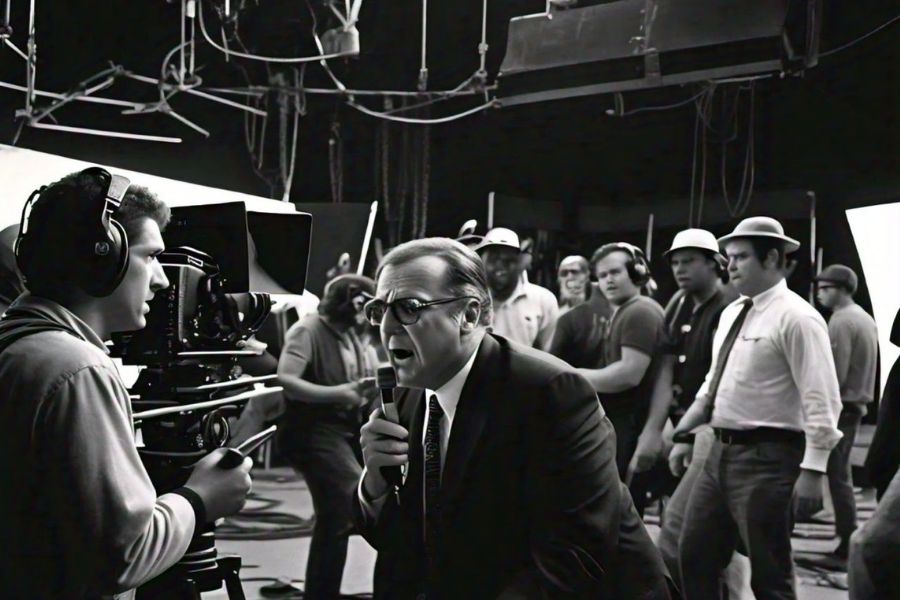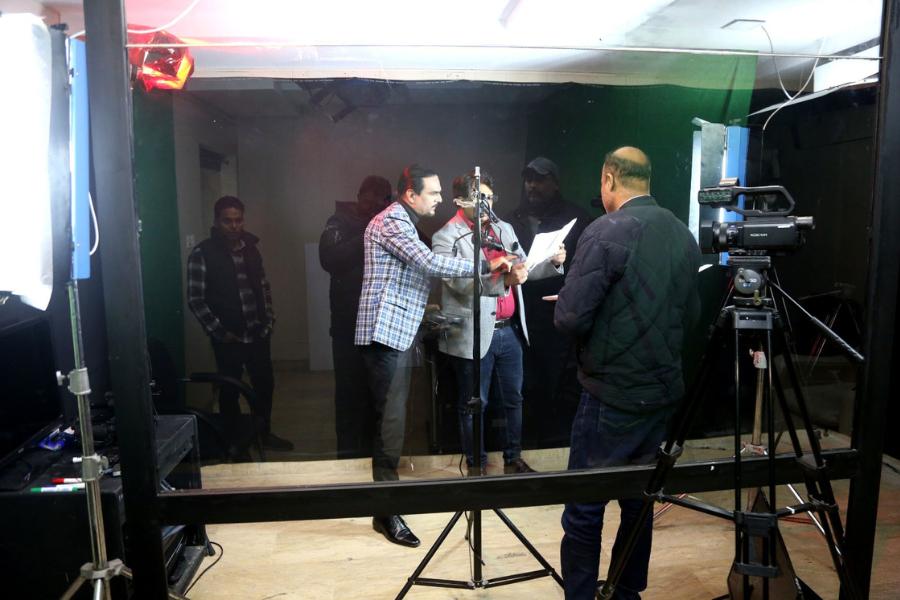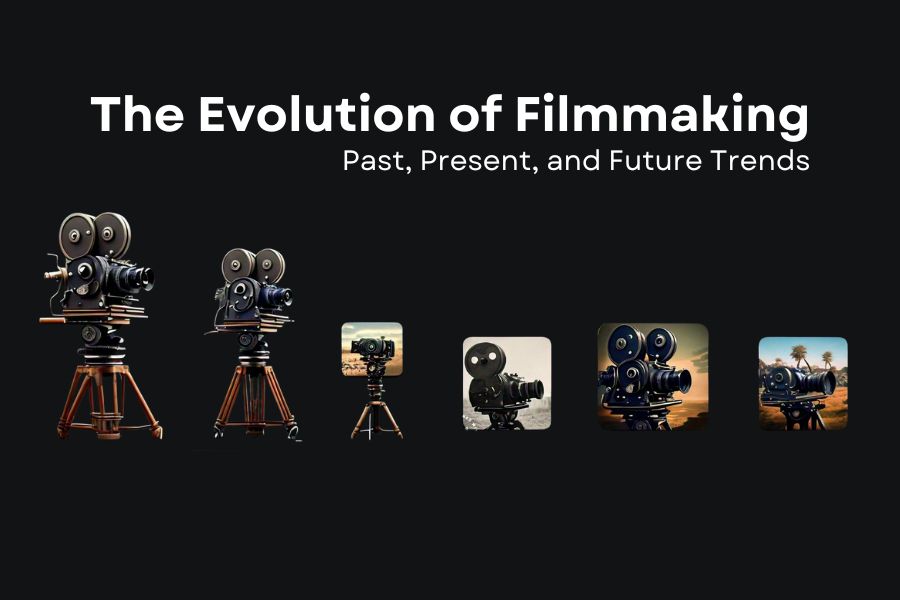Table of Contents
What’s up, fellow cinephiles! Ahmed Afridi, here to take you on an epic journey through the history of filmmaking. From the silent flicks of yesteryears to the mind-blowing CGI spectacles of today, strap yourselves in cause we’re about to dive deep into the mesmerizing world of movies.
1. Introduction
Let’s start by explaining the beginning. Imagine this: it’s the late 1800s, and some creative people are experimenting with cameras, trying to record moving images. And that’s how filmmaking began.
2. The Silent Era (Late 1800s – 1920s)

Back in the day, movies didn’t have soundtracks or dialogue. It was all about visual storytelling. Think Charlie Chaplin’s iconic slapstick antics and Georges Méliès’ whimsical fantasies. In the early days of cinema, soundtracks and spoken dialogue were absent, relying solely on visuals to convey storytelling. This era birthed cinematic legends and timeless classics. The silent era boasted diverse genres and styles.
Charlie Chaplin epitomized silent film comedy, utilizing physical humor in films like “The Gold Rush” (1925) and “City Lights” (1931).
Georges Méliès, a French filmmaker, pioneered fantastical special effects in works such as “A Trip to the Moon” (1902), crafting enchanting worlds on screen.
3. The Rise of Sound (1920s – 1950s)

Fast forward to the Roaring Twenties, and bam! Sound comes onto the scene, changing the game forever. Suddenly, we’re not just watching movies; we’re hearing them too. Cue the jazz hands and catchy tunes!
Paving the Way for Sound: Experiments with synchronized sound began in the early 1900s. Lee De Forest’s Phonofilm system in 1900 and Warner Bros.’ Vitaphone shorts in the 1920s laid the groundwork.
The “Talkie” Arrives: The 1927 release of The Jazz Singer (starring Al Jolson) is often hailed as the first full-length talking picture, although Warner Bros.’ Don Juan (1926) had some synchronized sound. The Jazz Singer sparked a sound revolution, with studios quickly converting to “talkies.”
Impact of Sound: Sound fundamentally changed filmmaking. Dialogue, sound effects, and music became integral storytelling tools. New genres, like musicals and gangster films, flourished. Actors with captivating voices, like Greta Garbo and Humphrey Bogart, rose to fame.
Challenges and Adaptations: Silent film stars with weak voices or thick accents sometimes struggled in the new era. Studios faced technical hurdles like bulky sound equipment and difficulty recording outdoors. However, filmmakers innovated, developing microphone placement techniques and soundstages for controlled recording.
4. The Golden Age of Hollywood (1930s – 1950s)
Ah, the glitz and glamour of Hollywood’s golden age. This was the era of big studios, bigger stars, and even bigger blockbusters. We’re talking iconic films like “Gone with the Wind” and “The Wizard of Oz” that still leave us in awe to this day.
The Golden Age of Hollywood, spanning the 1930s to 1950s, was marked by major studios like MGM, Paramount, Fox, Warner Bros and RKO, which controlled every aspect of filmmaking.
It was an era of larger-than-life movie stars such as Humphrey Bogart, Cary Grant, Greta Garbo, and Marilyn Monroe, with studios heavily investing in their image and careers.
Iconic films from this era include “Gone with the Wind” (1939), “The Wizard of Oz” (1939), “Casablanca” (1942), “Singin’ in the Rain” (1952), and “Citizen Kane” (1941), which continue to be beloved classics.
5. The New Hollywood Era (1960s – 1970s)
The ’60s and ’70s ushered in a new wave of filmmaking, with directors like Francis Ford Coppola and Martin Scorsese shaking things up. It was all about pushing boundaries and telling stories that were raw, gritty, and oh-so-real.
The Godfather (1972): Directed by Francis Ford Coppola, this epic gangster saga remains a landmark of American cinema. It delves into themes of family, loyalty, and the corrupting sway of power.
Taxi Driver (1976): Martin Scorsese’s dark and disturbing psychological thriller delves into the mind of a Vietnam veteran grappling with isolation and violence.
Bonnie and Clyde (1967): Directed by Arthur Penn, this film broke new ground with its graphic violence and portrayal of a dysfunctional couple on a crime spree. It’s considered a defining film of the New Hollywood era.
Chinatown (1974): Roman Polanski’s neo-noir masterpiece is a cynical and suspenseful exploration of corruption, deceit, and the American Dream gone sour.
One Flew Over the Cuckoo’s Nest (1975): Milos Forman’s powerful drama explores themes of rebellion, individuality, and the struggle against institutional power.
6. The Blockbuster Era (1980s – 1990s)

Cue the neon lights and epic soundtracks, it’s the era of the blockbuster! We’re talking about movies that blew our minds and broke box office records. From “E.T.” to “Titanic,” these films defined a generation.
E.T. the Extra-Terrestrial (1982): Steven Spielberg’s heartwarming story of a lost alien and a young boy resonated with audiences of all ages, becoming the highest-grossing film of all time (until Star Wars surpassed it a few years later).
Raiders of the Lost Ark (1981): This action-adventure film from director Steven Spielberg and producer George Lucas revitalized the serial adventure genre and spawned a hugely successful franchise for Harrison Ford as Indiana Jones.
Back to the Future (1985): This time-traveling comedy from director Robert Zemeckis blended humor, adventure, and science fiction into a pop culture phenomenon.
Jurassic Park (1993): Steven Spielberg once again pushed the boundaries of filmmaking with this groundbreaking special effects-laden dinosaur adventure.
Titanic (1997): James Cameron’s epic romance about the doomed ocean liner became the highest-grossing film of all time (until Avatar surpassed it over a decade later).
7. The Digital Age (2000s – Present)

Welcome to the digital revolution, folks! Cameras got smaller, CGI got crazier, and streaming platforms changed the game entirely. Suddenly, everyone with a smartphone could be a filmmaker, did they take advantage of it.
Rise of Citizen Filmmakers:
- Smartphones with high-quality cameras democratized filmmaking, leading to a surge in user-generated content.
- YouTube’s emergence in 2005 provided a platform for new creators, fostering a new era of online entertainment.
Evolution of Special Effects:
Advancements in CGI allowed filmmakers to create previously impossible worlds and creatures, as seen in movies like Avatar (2009).
The Streaming Boom:
Streaming services such as Netflix and Hulu disrupted traditional viewing habits, providing vast libraries of on-demand content.
Examples of the digital age empowering citizen filmmakers include:
Sean Baker’s critically acclaimed film “Tangerine” (2015), shot entirely on an iPhone, showcasing professional-quality filmmaking with accessible technology.
Citizen journalists utilizing platforms like Twitter and Facebook to provide unfiltered perspectives on current events in real-time.
8. Future Trends in Filmmaking
So, what does the future hold for filmmaking? Well, my friends, it’s looking pretty darn exciting. We’re talking virtual reality, artificial intelligence, and who knows what else.
Virtual Reality (VR) and Augmented Reality (AR):
Imagine stepping into a movie, not just watching it. VR allows viewers to wear headsets and enter the world of the film, while AR overlays digital elements onto the real world.
Example: Studios like Lucasfilm’s ILMxLAB create VR experiences that tie in with Star Wars and other franchises.
Artificial Intelligence (AI):
AI can streamline filmmaking processes, analyze data to predict audience preferences, and even generate scripts or create special effects.
Example: The movie “Avengers: Endgame” used AI to create realistic crowd simulations for massive battle scenes.
Conclusion
And there you have it, folks – the evolution of filmmaking in all its glory. From humble beginnings to mind-blowing CGI, it’s been one heck of a ride. But hey, the show isn’t over yet. So grab your popcorn, sit back, and let’s see where the silver screen takes us next.
FAQs
1. How did sound revolutionize filmmaking?
The invention of synchronized sound transformed movies from silent spectacles to immersive experiences, opening up new possibilities for storytelling.
2. Who were some of the key players during Hollywood’s golden age?
Legends like Alfred Hitchcock, Orson Welles, and Marilyn Monroe dominated the silver screen during this glamorous era.
3. What defines the new Hollywood era of filmmaking?
The ’60s and ’70s saw a shift towards more daring and experimental films, with directors like Francis Ford Coppola and Martin Scorsese leading the charge.
4. What role do streaming platforms play in the digital age of filmmaking?
Streaming services like Netflix and Hulu have democratized the industry, giving filmmakers new avenues to showcase their work and reach global audiences.
5. What can we expect from the future of filmmaking?
Get ready for mind-bending VR experiences, AI-driven storytelling, and who knows what else. The potential of filmmaking knows no bounds, limited solely by our imagination.

